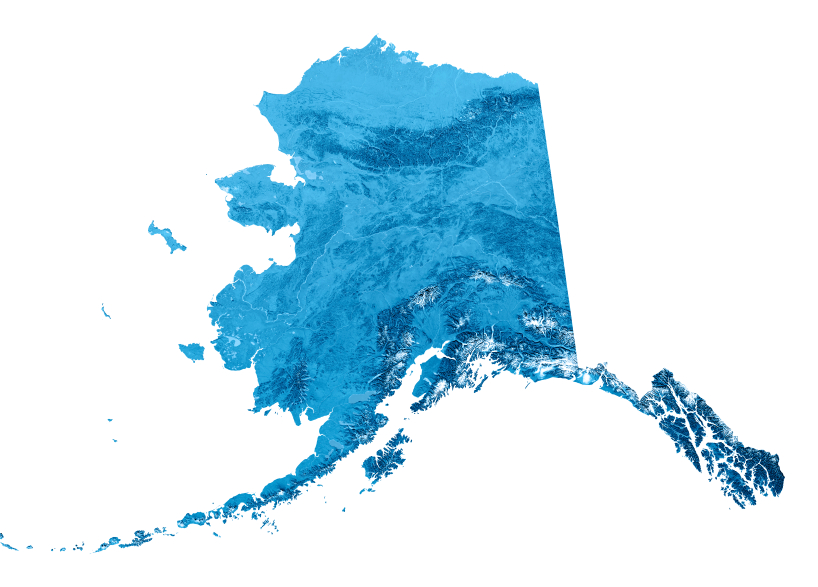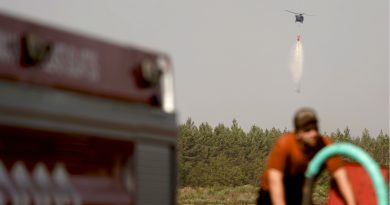New knowledge about ancient Arctic life is reshaping understanding of dinosaurs

Alaska’s North Slope teems with Arctic wildlife, from bears and caribou to lightweight birds that migrate from as far away as South America to breed in the long daylight.
Seventy million years ago, it was also teeming with Arctic wildlife — dinosaurs that thrived in polar conditions. As another exploration season gets underway, scientists hope to learn more those prehistoric creatures.
Since the first North Slope dinosaur bones were discovered by a petroleum geologist in 1961, knowledge has expanded exponentially, with a trove of bones producing new finds of previously unknown species. The North Slope dinosaur finds have upended past assumptions about dinosaurs as cold-blooded giant lizards and led to a developing portrait of creatures that were able to survive cold and dark winters by internally regulating their body temperatures —possible warm-bloodedness.
“Finding dinosaurs that far north says, ‘Wow, those dinosaurs are capable of living in environments that we just never thought possible,'” said paleontologist Pat Druckenmiller, curator of earth science at the University of Alaska Museum of the North in Fairbanks.
Polar dinosaurs can be found in very few places, and “Alaska’s the best place in the world,” said Druckenmiller, who is heading to the North Slope this summer to continue his exploratory work.
In the late Cretaceous period, from about 65 million years ago to 100 million years ago, the central North Slope was a coastal plain, with sometimes-overflowing rivers flowing northward out of the mountains into the ocean. But it was considerably warmer, with bigger plants, saidTony Fiorillo, curator of earth sciences at the Perot Museum of Nature and Science in Dallas and an expert on polar dinosaurs, who is also preparing for a North Slope expedition this summer.
Information from plant fossils and other sources has allowed scientists to reconstruct a climate that was something like the northern Rockies or Pacific Northwest — something between Oregon and Alberta, Fiorillo said.
[World’s farthest-north dinosaur bone find sheds light on Cretaceous world]
The period had snow and a longer stretch of all-day winter darkness than today, he said. What is the present-day North Slope was actually farther north in the Cretaceous period, possibly as far north as latitude 85 degrees, he said. That compares to the present-day latitude of 71.3 degrees for Barrow, Alaska’s northernmost community. The change in latitude for the North Slope is the result of gradual shifts in the North American continent, which was likely hinged at the site of what is now Canada’s Mackenzie River Delta, Fiorillo said. The gradual movement southward was what pushed up the mountains that became today’s Brooks Range, he said.
The evidence suggests that polar dinosaurs stayed in the area throughout the year and did not migrate south, so they made do in the cold, dark months. Individual species adapted to the conditions, like developing huge eyes that meat-eating troodons used to help them find prey in the dark, Fiorillo said.
Were Arctic dinosaurs warm-blooded?
The presence of such northern dinosaurs has led to an important question for scientists: Were they warm-blooded? The answer is still unknown, he said. “But clearly, there was some sort of thermal regulation.”
On the North Slope, the National Petroleum Reserve-Alaska, which encompasses much of western Arctic Alaska and which is the site of new oil development, is a hotbed of dinosaur discoveries. Within the reserve, the Colville River, the longest river on the North Slope, has become a treasure trove for dinosaur researchers, thanks to its geologic structure.
Consider the river to be like a knife slicing through tundra and permafrost dating back several thousand years down to the late Cretaceous bedrock, Druckenmiller said.
Though the Colville River itself did not exist in the Cretaceous period, other rivers flowed down from the early version of the Brooks Range, he said. Dinosaurs were discovered covered with sediment piled in layers on top, some of it containing important Pleistocene relics like woolly mammoth bones. As the river flows and erodes its banks, the past is revealed. Erosion in the ice-rich permafrost is a “double-edged sword,” exposing resources that need to be retrieved quickly, Druckenmiller said.
“We’re glad to have found it, but now there’s a chance that it’s going to erode away if we don’t go up and get it,” he said.
[Introducing the Arctic dinosaurs, T-Rex’s ‘weird’ northern cousins]
To date, several notable discoveries have been made along the Colville.
A team led by Fiorillo pieced together bones that turned out to be a new-to-science horned dinosaur, ultimately named Pachyrhinosuarus perotum in honor of Ross Perot and his family, patrons of the museum. Fiorillo and his partners also identified another new-to-science dinosaur, a pygmy tyrannosaur they named Nanuqsaurus hoglundi, incorporating an Inupiaq term that roughly translates to “polar bear lizard.”
Last year, Druckenmiller and his research partners announced discovery of a hadrosaur – a duck-billed herbivore – with hundreds of teeth to gnaw on plants. The species now bears the name Ugrunaaluk kuukpikensis, which incorporates Inupiaq terms and translates to “ancient grazer of the Colville.”
And there are some promising leads, such as a tiny dinosaur that appears to be related to a species that dug burrows, suggesting the possibility of ancient hibernation, Druckenmiller said.
Discovery by Shell geologist
The Colville overlies a late Cretaceous rock formation called Prince Creek; along the river is the site where Shell geologist Robert Liscomb spotted the North Slope’s first known dinosaur bones. That site, now called the “Liscomb Bonebed,” has produced about 6,000 bones to date. The remains of many animals were jumbled together there over time, Druckenmiller said.
“It’s like taking a whole bunch of duck-billed dinosaurs, sticking them in a blender and spewing them all over the landscape,” he said.
Dinosaurs roamed the entire territory that is now known as the North Slope, and discoveries have been made far away from the Colville. But for many reasons, including sedimentary patterns and varying acidity of those sediments, bones are not as well-preserved elsewhere as in the Colville area, leaving fossilized footprints as the most likely finds, Druckenmiller said.
Fiorillo, who has worked extensively on the Colville, is headed later this summer to one of those other areas, a site along the remote Kukpowruk River on the western edge of the North Slope, just over the National Petroleum Reserve border. He is returning to a site where he worked last year, and where he found footprints in the approximately 100 million-year-old rock.
During that part of the Cretaceous period, the Bering Land Bridge was young and the climate was even warmer than it was 70 million years ago, with lots of trees — but still not the hot jungle of popular imagination.
“It’s a pretty lush vegetation. But it’s definitely not tropical,” Fiorillo said.
Just as Alaska is a new frontier for dinosaur discoveries, the National Petroleum Reserve is a late bloomer for oil development.
The reserve was established nearly a century ago by President Warren Harding as one of four national petroleum reserves intended to supply fuel to the U.S. Navy, which was switching from coal to oil. It is a footnote in the Teapot Dome scandal, which centered on rigged bids at another reserve in Wyoming.
Despite the names bestowed on the 23 million-acre reserve — Naval Petroleum Reserve 4, replaced in the 1970s by National Petroleum Reserve-Alaska — very little oil development has been done there. Oil searches in the second half of the 20th century, conducted by government and industry geologists, were mostly futile, producing little more than abandoned and obsolete well sites, some of which are now being addressed with a belated cleanup program.
New interest in reserve
The 1990s discovery of the Alpine field on state land in the Colville River delta led to new interest in oil development in the reserve and a series of modern lease sales, exploratory wells and, ultimately, to the first oil production late last year within the lands that Harding established as an oil reserve. More production is expected as development expands west. Another lease sale, the 12th in the modern series, is planned for later this year.
Though dinosaur fossils are found in the type of sandstones that also often contain oil, scientists are quick to point out that oil comes from fossilized algae and marine organisms, not fossilized dinosaurs — contrary to some myths promoted in popular culture.
Still, modern oil searchers and dinosaur hunters share the same general territory and sometimes cross paths. A couple of years ago, for example, when Fiorillo was working on the Colville, he briefly thought he was hallucinating when he saw a bright light on the northern horizon; it turned out to be a gas flare at a Colville oil site.
Modern life on the North Slope overlaps the Cretaceous past in another way: The National Petroleum Reserve is well-known for its huge congregations of birds.
“There’s a really good reason all these birds are flying several thousand miles just to eat and raise their young and then turn around a couple months later and fly back,” said Melanie Smith, a scientist with Audubon Alaska.
The high cliffs of the Colville uplands are ideal habitat for birds of prey. The wide delta, with its fan of freshwater channels flowing into saltwater, provides a variety of plant and marine food to support globally significant populations of migrating shorebirds.
Vast Teshekpuk Lake and other lakes and ponds that dot the tundra shelter molting waterfowl.
“If you’re a goose and you can’t fly for a few weeks, you need to be out in the middle of a lake where you can’t get picked off by a fox or something,” Smith said. And Kasegaluk Lagoon, on the western part of the North Slope, has shallow, sheltered waters with plentiful food for birds stopping by during long migrations, she said.
To Fiorillo, it is fitting that the region that once was home to dinosaurs is now a haven for birds.
In the past, scientists pondered the similarities between dinosaurs and birds, with their common beaks, claws and egg-laying habits and sometimes feathers. Now they’ve concluded that the relationship is a direct line of descent.
“We now know that birds are dinosaurs,” Fiorillo said.
Related stories from around the North:
Canada: Arctic science cooperation agreement ‘good for Canada’ – POLAR, Radio Canada International
Russia: Japan wants more Arctic cooperation with Russia, The Independent Barents Observer
Sweden: Canada & Sweden cooperate on Arctic science, Eye on the Arctic
United States: Alaska & Russia join forces to create database of walrus haulouts dating back 160-years, Alaska Dispatch News



